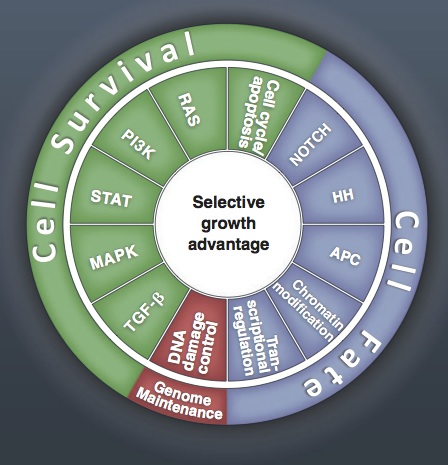This beautifully written review of cancer genetics tells us what the researchers all over the world have learned about differences in normal and cancer genomes. Sequencing technologies are becoming less and less expensive and hopefully very soon we will see sequencing as part of routine clinical testing. Although we are not there yet. The authors of the article provide this outline:
1. Most human cancers are caused by two to eight sequential alterations that develop over the course of 20 to 30 years.
2. Each of these alterations directly or indirectly increases the ratio of cell birth to cell death; that is, each alteration causes a selective growth advantage to the cell in which it resides.
3. The evidence to date suggests that there are ~140 genes whose intragenic mutations contribute to cancer (so-called Mut-driver genes). There are probably other genes (Epi-driver genes) that are altered by epigenetic mechanisms and cause a selective growth advantage, but the definitive identification of these genes has been challenging.
4. The known driver genes function through a dozen signaling pathways that regulate three core cellular processes: cell fate determination, cell survival, and genome maintenance.
5. Every individual tumor, even of the same histopathologic subtype as another tumor, is distinct with respect to its genetic alterations, but the pathways affected in different tumors are similar.
6. Genetic heterogeneity among the cells of an individual tumor always exists and can impact the response to therapeutics.
7. In the future, the most appropriate management plan for a patient with cancer will be informed by an assessment of the components of the patient’s germline genome and the genome of his or her tumor.
8. The information from cancer genome studies can also be exploited to improve methods for prevention and early detection of cancer, which will be essential to reduce cancer morbidity and mortality.
Those 138 mut-driver genes (oncogenes and tumor suppressor genes) can be classified into one or more of 12 pathways. And these pathways can be grouped into three large groups: cell survival, cell fate and genome maintenance. All these things go wrong during aging. The majority of the listed pathways play a role in aging. Naturally, cell senescence is seen as an anti-cancer strategy of the cell. And it works well until it doesn’t. The relationship between these two processes is not understood completely and more research is definitely needed to answer the question what happens over time. What distorts the balance?
Cancer is truly an age-related disease. Aging brings decline in DNA repair efficiency and other mechanisms of genome stability maintenance. I think that if we figure out a way how to keep those mechanisms intact, working as good as they do at the age of 16, for example, there’s a good chance we will eradicate cancer, at least the solid tumors. This will be a huge step in increasing human longevity.
I wholeheartedly agree with the authors of the article on the following matter:
“plan A” should be prevention and early detection, and “plan B” (therapy for advanced cancers) should be necessary only when plan A fails. To make plan A viable, government and philanthropic organizations must dedicate a much greater fraction of their resources to this cause, with long-term considerations in mind. We believe that cancer deaths can be reduced by more than 75% in the coming decades (152), but that this reduction will only come about if greater efforts are made toward early detection and prevention.
This idea of prevention is valid not only for cancer, but for aging in general. In my opinion, if we develop the tests, that will definitely include cancer testing, we will be able to see what is happening, what is going wrong on molecular level, and we won’t wait until 90% of the organ is non-functional, until Alzheimer’s have consumed the personality of our loved one, until we feel we can no longer walk up three staircases. We will fight the disease in its infancy, and we will fight aging to remain youthful for as long as we choose to be.

